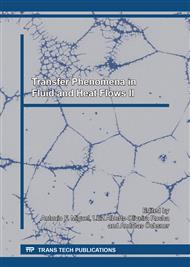[1]
C.P. Jacovides, G. Mihalakakou, M. Santamouris and J.O. Lewis, On the ground temperature profile for passive cooling applications in buildings. Sol. Energy 57 (1996) 167-175.
DOI: 10.1016/s0038-092x(96)00072-2
Google Scholar
[2]
C. Peretti, A. Zarrella, M. Carli and R. Zecchin, The design and environmental evaluation of earth-to-air heat exchangers (EAHE). A literature review. Renew. Sustain. Energy Rev. 28 (2013) 107-116.
DOI: 10.1016/j.rser.2013.07.057
Google Scholar
[3]
L.T. Rodrigues and M. Gillott, A novel low-carbon space conditioning system incorporating phase-change materials and earth–air heat exchangers. Int. J. Low-Carbon Tech. 10 (2015) 176-187.
DOI: 10.1093/ijlct/ctt023
Google Scholar
[4]
J. Sobti and S.K. Singh, Earth-air heat exchanger as a green retrofit for Chandīgarh - a critical review. Geotherm. Energy (2015) 3: 14 DOI 10. 1186/s40517-015-0034-4.
DOI: 10.1186/s40517-015-0034-4
Google Scholar
[5]
P. Hollmuller and B. Lachal, Cooling and preheating with buried pipe systems: monitoring, simulation and economic aspects. Energy Build. 33 (2001) 509-518.
DOI: 10.1016/s0378-7788(00)00105-5
Google Scholar
[6]
J. Pfafferott, Evaluation of earth-to-air heat exchangers with a standardised method to calculate energy efficiency. Energy Build. 35 (2003) 971-983.
DOI: 10.1016/s0378-7788(03)00055-0
Google Scholar
[7]
J. Vaz, M. Sattler, R.S. Brum, E.D. Santos and L.A. Isoldi, An experimental study on the use of earth-air heat exchangers (eahe). Energy Build. 72 (2014) 122-131.
DOI: 10.1016/j.enbuild.2013.12.009
Google Scholar
[8]
R.S. Brum, L.A.O. Rocha, J. Vaz, E.D. Santos and L.A. Isoldi, Development of simplified numerical model for evaluation of the influence of soil-air heat exchanger installation depth over its thermal potential. Int. J. Adv. Renew. Energy Res. 1 (2012).
Google Scholar
[9]
G. Mihalakakou, M. Santamouris and D. Asimakopoulos, Modelling the thermal performance of earth-to-air heat exchangers. Sol. Energy 53 (1994) 301-305.
DOI: 10.1016/0038-092x(94)90636-x
Google Scholar
[10]
M. Paepe and A. Janssens, Thermo-hydraulic design of earth-air heat exchangers. Energy Build. 35 (2003) 389-397.
DOI: 10.1016/s0378-7788(02)00113-5
Google Scholar
[11]
H. Wu, S. Wang and D. Zhu, Modelling and evaluation of cooling capacity of earth-air-pipe systems. Energy Convers. Manage. 48 (2007) 1462-1471.
DOI: 10.1016/j.enconman.2006.12.021
Google Scholar
[12]
R.S. Brum, J.V.A. Ramalho, L. A. O. Rocha, L. A. Isoldi and E. D. dos Santos, Transient Models to Analyze the Influence of the Air Velocity and Ducts Diameter on the Performance of Earth-Air Heat Exchangers. Int. J. Fluid Mech. Res. 43 (2016).
DOI: 10.1615/interjfluidmechres.v43.i5-6.100
Google Scholar
[13]
F. Ascione, L. Bellia and F. Minichiello, Earth-to-air heat exchangers for Italian climates. Renew. Energy 36 (2011) 2177-2188.
DOI: 10.1016/j.renene.2011.01.013
Google Scholar
[14]
V. Bansal, R. Misra, G.D. Agrawal and J. Mathur, Performance analysis of earth-pipe-air heat exchanger for winter heating. Energy Build. 41 (2009) 1151-1154.
DOI: 10.1016/j.enbuild.2009.05.010
Google Scholar
[15]
V. Bansal, R. Misra, G.D. Agrawal and J. Mathur, Performance analysis of earth-pipe-air heat exchanger for summer cooling. Energy Build. 42 (2010) 645-648.
DOI: 10.1016/j.enbuild.2009.11.001
Google Scholar
[16]
R.S. Brum, J. Vaz, L.A.O. Rocha, E.D. Santos and L.A. Isoldi, A new computational modeling to predict behavior of earth-air heat exchangers. Energy Build. 64 (2013) 395–402.
DOI: 10.1016/j.enbuild.2013.05.032
Google Scholar
[17]
A. Bejan and S. Lorente, Design with Constructal Theory, John Wiley & Sons, Hoboken, (2008).
Google Scholar
[18]
M.K. Rodrigues, R.S. Brum, J. Vaz, L.A.O. Rocha, E.D. Santos and L.A. Isoldi, Numerical investigation about the improvement of the thermal potential of an earth-air heat exchanger (eahe) employing the constructal design method. Renew. Energy 80 (2015).
DOI: 10.1016/j.renene.2015.02.041
Google Scholar
[19]
H. Kobayashi, S. Lorente, R. Anderson and A Bejan, Serpentine thermal coupling between a stream and a conducting body. J. Appl. Phys. 111 (2012) 044911.
DOI: 10.1063/1.3689152
Google Scholar
[20]
M. R. Errera, S. Lorente, A. Bejan, Assemblies of heat pumps served by a single underground heat exchanger. Int. J. Heat Mass Transfer 75 (2014) 327-336.
DOI: 10.1016/j.ijheatmasstransfer.2014.03.039
Google Scholar
[21]
L.A.O. Rocha, S. Lorente, A. Bejan and R. Anderson, Constructal design of underground heat sources or sinks for the annual cycle. Int. J. Heat Mass Transfer 55 (2012) 7832-7837.
DOI: 10.1016/j.ijheatmasstransfer.2012.08.010
Google Scholar
[22]
F.P. Incropera, D.P. Dewitt, T.L. Bergman and A.S. Lavine, Fundamentals of Heat and Mass Transfer, John Wiley & Sons, Hoboken, (2007).
Google Scholar
[23]
H.K. Versteeg and W. Malalasekera, An Introduction to Computational Fluid Dynamics – The Finite Volume Method, Pearson Education, London, (2007).
Google Scholar
[24]
D.C. Wilcox, Turbulence Modeling for CFD, DCW Industries, Califórnia, (2006).
Google Scholar
[25]
R.S. Brum, J.V.A. Ramalho, L.A.O. Rocha, L.A. Isoldi and E.D. Santos, A matlab code to fit periodic data. Revista Brasileira de Computação Aplicada 7 (2015) 16-25.
DOI: 10.5335/rbca.2015.4618
Google Scholar
[26]
F.M. White, Fluid Mechanics, McGraw-Hill, New York, (2011).
Google Scholar
[27]
J.H. Lienhard IV and J.H. Lienhard V, A heat transfer textbook, Phlogiston Press, Massachussets, (2003).
Google Scholar
[28]
H.S. Lee, Thermal design: heat sinks, thermoelectrics, heat pipes, compact heat exchangers, and solar cells, John Wiley & Sons, Hoboken, (2010).
DOI: 10.1002/9780470949979.ch5
Google Scholar


